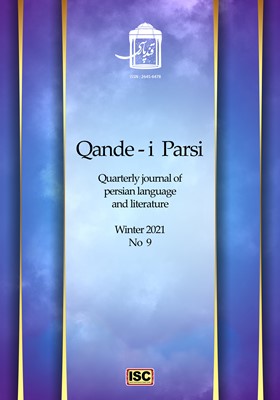The Functional of Epithets in Hafez’s Sonnets
Subject Areas : Analysis of order texts
1 - assistant perofessor
Keywords: Hafez’s sonnets, epithets, functional, beautification, uglification, magnification,
Abstract :
Epithets are attributes that, unlike attributes in the grammatical and logical sense, have many artistic and poetic functions, and in this way, cause the poetry language to be distinguished.Hafez is superior in the discovery, construction, and use of this type of epithets, but his artistic techniques have not been well studied yet, and as a result, most of the opinions on this subject are presented just about a few of his poems; so the present paper tried to examine this issue in Hafez’ sonnetsscientifically using the content analysis. According to this paper, it has been determined that Hafez has over 1400 descriptive compositions, 560 successor attributes, and 58 descriptive groups, from which more than 480 are epithets; that is, they have aesthetic function and made the language prominence. These epithets are analyzed in this paper based on the type of function, and it has been determined that the epithets of Hafez in his sonnets have the functions of beatification (Sarve Senoubarkharaam), uglification (Dajal Fe’l Molhedolshekl), magnification (Zabaane Atashin), metaphorical (Ashke ghammaz), sarcastic(Kootah Astinaan), simile (Dele senoubari) and allegory (Adame Beheshti). Since most of them are associated with a kind of innovation and fantasizing, they have cause the poetic language to be prominent and distinguished; therefore, Hafez is a great poet in this regard. This issue can be studied on literary masterpieces such as Shahnameh and Boostan by which the different epithets can be found in literary genres.
فهرست منابع
امیری، سیدمحمد و سیدعلی محمودی لاهیجانی، (1393)، «بررسی تطبیقی صفتهای هنری در ایلیاد و ادیسة هومر و شاهنامة فردوسی»، مجلة کهننامة پارسی، سال پنجم، شمارة 2، صص 23- 44.
حافظ.شمسالدین محمد، (1374)، دیوان، به تصحیح محمد قزوینی و قاسم غنی، چاپ پنجم، تهران: اساطیر.
حمیدیان، سعید، (1383)، درآمدی بر اندیشه و هنر فردوسی، چاپ دوم، تهران: ناهید.
دهرامی، مهدی، (1394)، «نقشهای هنری صفت در ایجاد زبان ادبی، تصویرسازی و کیفیت عاطفه و اندیشه در شعر شاملو»، مجلة زیباییشناسی ادبی، شمارة 23، صص 19- 38.
شمیسا. سیروس، (1370)، بیان، تهران: فردوس و مجید.
شفیعی، محمود، (1349)، «ارزش ادبی و اهمیّت شاهنامه از نظر دستور زبان»، چاپشده در مجموعه مقالات سخنرانی و بحث دربارة شاهنامة فردوسی، تهران، ج دوم، صص127- 142.
شفیعی کدکنی، محمدرضا، (1391)، رستاخیز کلمات (درس گفتارهایی دربارة نظریة ادبی صورتگرایان روس)، چاپ دوم، تهران: سخن.
، (1397)، این کیمیای هستی دربارة حافظ (جمالشناسی و جهان شعری)، چاپ دوم، تهران: سخن.
، (1376)، موسیقی شعر، چاپ پنجم، تهران: آگه.
، (1372)، صور خیال در شعر فارسی، چاپ پنجم، تهران: آگاه.
صفوی، کورش، (1383)، از زبانشناسی به ادبیات، جلد اول: نظم، تهران: سورة مهر.
غلامرضایی، محمد، (1387)، سبکشناسی شعر پارسی از رودکی تا شاملو، چاپ سوم، تهران: جامی.
فتوحی، محمود، (1391)، سبکشناسی، تهران: سخن.
فرشیدورد، خسرو، (1357)، در گلستان خیال حافظ، تهران: انتشارات بنیاد نیکوکاری نوریانی.
فرشیدورد، خسرو، (1374)، «صفتهای شاعرانه در شاهنامه و مقایسة آن با آثار دیگر»، چاپشده در مجموعه مقالات کنگرة جهانی بزرگداشت فردوسی (نمیرم از این پس که من زندهام)، به کوشش غلامرضا ستوده، تهران: دانشگاه تهران، صص 195- 210.
محمودی لاهیجانی، سیدعلی و دیگران، (1395)، «فرمولهای اسم- صفت هنری در شاهنامة فردوسی میراثی از سرودههای شفاهی در خداینامة پهلوی»، مجلة جستارهای ادبی، شمارة 193، صص 21- 51.
یوسفی، غلامحسین، (1369)، «موسیقی کلمات در شعر فردوسی»، مجلة ادبستان فرهنگ و هنر، شمارة 12، صص 8- 16.
منابع لاتین:
C. H. Holman. (1975), "A Hand to Literature", third edition. P. 201.
Erlich. Victor. (1980), "Russian Formalism, History- Doctorine",fourth ed. Mouton Publishers, the Hague, Paris, New York.P. 251.
Lemon, lee T. and MARISON, j. Rais. (1965), (translated and introduced by) Russian Formalism Criticism four Essays, University of Nebraska Press, London. P. 8.
Jean-paul Sartre. (1965), What is Literature? Tr. By Bernard, Frechtman, New York: Harper& Row. P.8.


